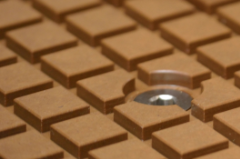This head is characterized by a very high oscillation force. Thanks to this, it is possible to cut through materials that offer very high resistance, as well as materials with a large thickness. With the use of an appropriate blade, it is possible to cut rubber with a thickness of up to 30mm. The oscillation speed is regulated by setting the desired value from the program in the range from 0 to 5000 movements per minute. If the value is set to 0, the blade automatically moves to the maximum forward position and the head performs work without oscillation. A speed range of about 1000 strokes per minute is typically used to make perforations in cardboard.
The oscillation is driven by pressurized air supplied to the machine. The oscillation speed and force are regulated by airflow control and cannot be fine-tuned from the computer. The head is characterized by a very high oscillating speed, thanks to which it is possible to cut materials with very high efficiency. Due to the way vibrations are generated...
The tool correction sensor enables automatic input of the tool length correction value mounted in the CNC chuck or directly in the spindle. The machine tool automatically measures the length of the tool, then corrects the Z axis coordinate so that the end of the tool is at the appropriate height. In machines equipped with an automatic tool change, the measurement may be performed once or before each use. It is also possible to measure the tool after machining to check for damage.
The head is used together with the cutting head (electric or pneumatic), allowing to make special bends, usually on the cardboard, enabling the material to be bent later. Usually, this head uses creasing wheels of various diameters and widths, as well as other tools, e.g. V-cut heads.
An additional head, mounted next to the cutting / milling head, allows for marking the workpiece. It has its own actuator, thanks to which it lowers automatically. It can be used both for inscriptions on details and for drawing preset shapes.
The functionality most often used in lasers manufactured by Kimla. A special printing head applies the marks set by the operator (usually the names of the elements) on the material, which allows for the subsequent identification of the cut details. This functionality is especially recommended for companies providing service cutting.
System of minimum lubrication with air-oil mixture fed to the cutting zone. It replaces the traditional, uneconomical cooling systems of the treatment zone based on emulsion solutions. Before the outlet nozzle, the air, supplied under pressure, mixes with the oil dosed in the volume of a few drops per minute...
A raster table made of HPL, on which the milled material (most often a plate) is placed and immobilized by means of a vacuum generated by a vacuum pump. Such a table has a number of grooves in which we can place a sealing profile and thus more accurately adjust the area of the suction to the format of the processed material.
It is an overpressure device used for local removal of fine chips or dust generated during the technological processing of, inter alia, wood, leather, fabrics, plastics, etc. materials. In one common housing there is a transport fan, a simplified cyclone and a dust collector...
A set of mechanical bases placed on the machine table, ensuring repeatability of the arrangement of the given material (usually boards). The operator, when placing the material on the table, pushes it against the protruding pins, thanks to which it is placed in the right place. This solution helps with large-scale production of elements.









